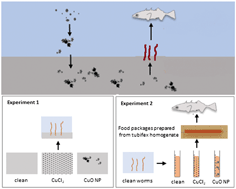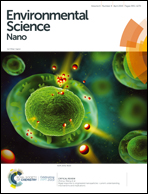Trophic transfer of CuO NPs and dissolved Cu from sediment to worms to fish – a proof-of-concept study†
Abstract
Man-made nanoparticles (NPs) released into the aquatic environment are likely to accumulate in sediment. Uptake of NPs by benthic invertebrates that serve as food for higher trophic level organisms such as fish may result in their transfer along the food chain. We tested this hypothesis in a proof-of-concept approach consisting of two studies examining the transfer of copper(II) oxide NPs (CuO NPs) (<50 nm) and dissolved copper (CuCl2). Study 1 focussed on transfer from sediment to worms (Tubifex tubifex) and study 2 on transfer from worms (T. tubifex) to fish (Gasterosteus aculeatus, three-spined stickleback). A key methodological achievement of study 2 was the development of worm homogenate-based food packages, which allowed controlling CuO NPs and CuCl2 dosing of fish. In T. tubifex, no significant differences in Cu accumulation were detected following 7 days of exposure to sediment-associated CuO NPs or CuCl2 (100 μg Cu per g dw sediment). Yet, metallothionein-like protein levels were significantly elevated in CuO NP-exposed worms compared to the control, while they were not in CuCl2-exposed worms. G. aculeatus fed CuO NP- and CuCl2-spiked food packages (2 μg Cu per g fish ww per day; 7 days) showed increased Cu concentrations (∼13 and ∼31 μg Cu per g dw compared to control, respectively) and metallothionein (mta) mRNA expression in intestinal tissue. In CuO NP-exposed fish, Cu and mta mRNA levels were noticeably lower than in CuCl2-exposed fish and inversely correlated with the amount of Cu in their faeces, suggesting that a large fraction of NPs was egested. Altogether, the results suggest that sediment-associated CuO NPs can enter the aquatic food web, but that transfer of CuO NPs from T. tubifex to stickleback may be limited compared to dissolved Cu. Furthermore, there were no indications of induction of oxidative stress in fish intestine and liver, suggesting that effects from environmentally relevant Cu/CuO NP exposure via the diet may be minimal.



 Please wait while we load your content...
Please wait while we load your content...